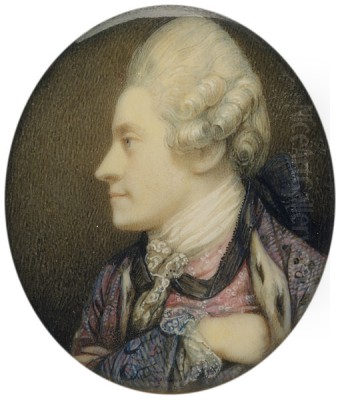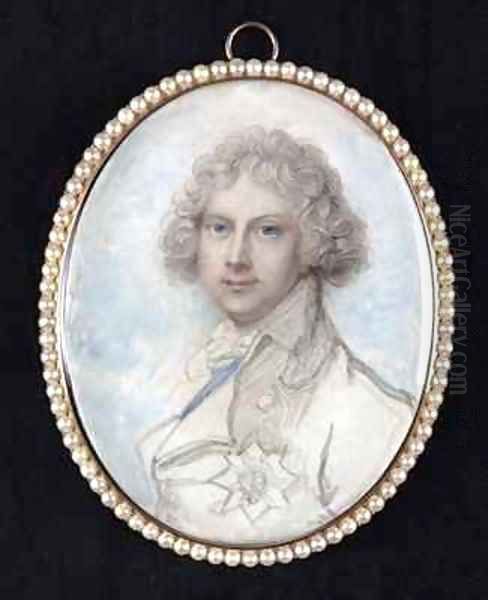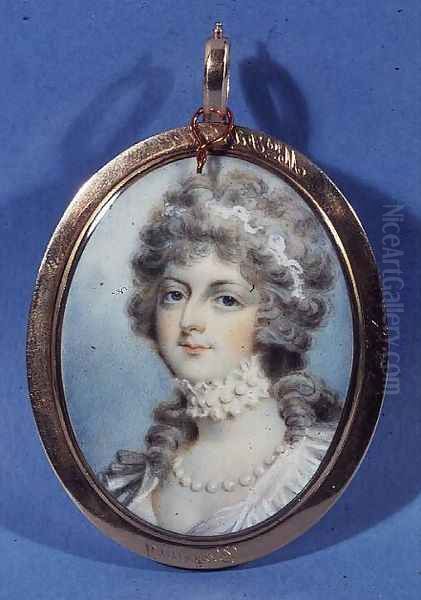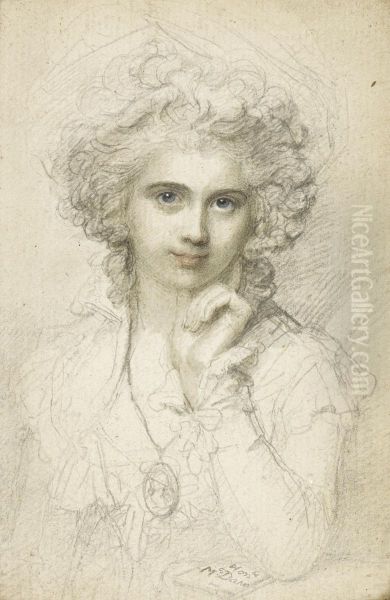
Richard Cosway stands as one of the most celebrated and distinctive portrait painters of late 18th and early 19th century Britain. Renowned primarily for his exquisite portrait miniatures, he captured the likenesses of royalty, aristocracy, and the fashionable elite with a unique blend of technical brilliance and refined elegance. His work, particularly his innovative use of watercolour on ivory, defined an era and left an indelible mark on the art of miniature painting. Operating within a vibrant and competitive London art scene, Cosway navigated the worlds of royal patronage, artistic rivalry, and complex personal relationships, creating a legacy that continues to fascinate art historians and enthusiasts alike.
Early Life and Artistic Formation
Richard Cosway was born on November 5, 1742, in Tiverton, Devon, England. His father was the master of Blundell's School in the town, providing a foundation of education for the young Richard. Showing early artistic promise, he was sent to London to pursue formal training in painting. This move proved pivotal, immersing him in the burgeoning artistic environment of the capital.
In London, Cosway honed his skills, likely studying initially under Thomas Hudson, a prominent portraitist of the time, though his most significant early training occurred at William Shipley's drawing school. Founded in 1754, Shipley's academy was a crucible for young talent, and it was here that Cosway encountered other aspiring artists who would become his contemporaries and sometimes rivals, including the notable miniaturists John Smart and William Wood. Cosway quickly distinguished himself, winning a prize from the Society of Arts (then the Society for the Encouragement of Arts, Manufactures and Commerce) in 1754, an early indicator of his burgeoning talent. By 1760, he felt confident enough to establish his own artistic practice.
The Royal Academy and Rising Reputation

The founding of the Royal Academy of Arts in London in 1768 marked a significant moment for the professionalization and prestige of British art. Richard Cosway was involved from the early stages, becoming one of the first group of Associates elected (ARA) in August 1770. His ascent within the Academy continued, and he was elected a full Royal Academician (RA) in 1781. This election was reportedly secured with the crucial casting vote of the Academy's first President, the influential Sir Joshua Reynolds, highlighting Cosway's growing standing within the established art world.
Membership in the Royal Academy provided artists with exhibition opportunities, professional status, and networking possibilities. Cosway regularly exhibited his works, primarily miniatures but also occasional larger paintings, at the Academy's annual exhibitions. This exposure helped solidify his reputation and attract the high-profile clientele that would become synonymous with his name. His technical skill and the fashionable appeal of his portraits quickly made him a sought-after artist among London's elite.
Master of the Miniature: Style and Technique
While Cosway produced some larger oil paintings and drawings, his enduring fame rests upon his mastery of the portrait miniature. He worked predominantly on ivory, a support material that gained popularity in the 18th century for its smooth surface and luminous quality. Cosway developed a highly distinctive technique, employing transparent watercolour pigments applied with remarkable delicacy.
Unlike some miniaturists who used denser colours, Cosway allowed the natural translucency and warmth of the ivory base to shine through his paint layers. This created a unique luminosity and softness, lending his portraits an ethereal, almost glowing quality. His brushwork was often characterized by rapid, short, feathery strokes, particularly noticeable in the rendering of hair and fabrics. Backgrounds were typically kept simple, often light washes of blue or grey suggesting sky or an indeterminate space, which served to focus attention entirely on the sitter.
Cosway possessed a remarkable ability to capture not only a physical likeness but also an air of aristocratic grace and psychological nuance. His portraits are rarely stiff or formal; instead, they convey a sense of intimacy and fashionable sensibility. He often slightly idealized his sitters, emphasizing large, expressive eyes and elegant postures, aligning his work perfectly with the refined tastes of the Regency era. This signature style, combining technical finesse with an innate understanding of elegance, set him apart from many contemporaries.
Principal Painter to the Prince of Wales: Royal Patronage

The pinnacle of Cosway's career success came through his association with George, Prince of Wales, the future King George IV. Known for his extravagant tastes and patronage of the arts, the Prince Regent became Cosway's most important supporter. In 1785, Cosway received the prestigious appointment of 'Primarius Pictor Serenissimi Walliae Principis', or Principal Painter to His Royal Highness the Prince of Wales.
This official title cemented Cosway's position at the forefront of British portraiture. He painted the Prince numerous times, capturing his evolving image over the years. He also received commissions to portray members of the Prince's circle, including his mistresses and associates. Beyond portraiture, Cosway was involved in the artistic schemes at the Prince's London residence, Carlton House, contributing to its lavish decoration, reportedly even painting mythological scenes on ceilings. This royal connection brought immense prestige and ensured a steady stream of commissions from the highest echelons of society, making Cosway one of the most fashionable and financially successful artists of his day. His Portrait of George, Prince of Wales remains a quintessential image of the future monarch in his youth.
Maria Cosway: An Artistic Partnership and Complex Marriage
In 1781, Richard Cosway married Maria Hadfield (1760-1838), an accomplished artist, musician, and composer in her own right. Born in Florence to British parents, Maria was talented, multilingual, and well-connected. Their marriage brought together two significant artistic talents. While some contemporaries viewed the match as one of convenience – Richard was considerably older and already established, while Maria brought youth and Continental sophistication – it undoubtedly created a dynamic partnership.
Maria Cosway pursued her own successful artistic career, specializing in historical and mythological subjects, often on a larger scale than her husband's miniatures. She exhibited regularly at the Royal Academy, and Richard was known to support her professional endeavors. He painted several striking portraits of her, showcasing her beauty and intelligence. Their home became a prominent social and cultural hub.

However, the marriage was not without its complexities and public scrutiny. Richard's flamboyant personality and rumoured affairs, including a supposed liaison with fellow Royal Academician Mary Moser, caused friction. Furthermore, Maria formed a deep and intense, though likely platonic, romantic friendship with the American statesman Thomas Jefferson during his time in Paris, a relationship documented in their correspondence. Richard's own personal life was subject to speculation, with persistent rumours regarding his sexuality circulating in society. Despite these challenges, the couple maintained a public partnership for many years, representing a powerful force in London's artistic and social scenes. A servant in their household, Ottobah Cugoano, an abolitionist writer, also notably served as a model for several paintings by Sir Joshua Reynolds.
Schomberg House: A Centre of Art and Society
During the height of their fame, Richard and Maria Cosway resided in Schomberg House on Pall Mall, London. This grand residence became more than just a home; it functioned as a studio, gallery, and one of the most fashionable salons in the city. The Cosways hosted lavish receptions, concerts, and soirées that attracted a glittering array of guests, including artists, writers, musicians, politicians, aristocrats, and even royalty.
Maria, an accomplished musician, often performed at these gatherings. The house itself was sumptuously decorated, filled with Richard's extensive collection of Old Master paintings, drawings, sculptures, and objets d'art, reflecting his status not only as a painter but also as a connoisseur and collector. Schomberg House symbolized the Cosways' success and their central position within the cultural life of late Georgian London, providing a crucial venue for networking, displaying their talents, and cultivating patronage. Their presence there solidified their image as arbiters of taste and fashion.
The Wider Artistic Circle: Contemporaries and Competitors
Richard Cosway operated within a rich and competitive artistic landscape in London. His direct rivals in the specialized field of miniature painting included figures he knew from his student days, such as the precise and highly skilled John Smart and William Wood. He also competed for patronage with painters working on a larger scale. The dominant figures of the era were Sir Joshua Reynolds, the first President of the Royal Academy, known for his Grand Manner portraits, and Thomas Gainsborough, celebrated for his fluid brushwork and sensitive portrayals.
Other significant portraitists active during Cosway's career included George Romney, whose elegant style rivalled Reynolds and Gainsborough in popularity for a time, and later, the brilliant Sir Thomas Lawrence, who would rise to become the leading portrait painter of the Regency and succeed Benjamin West (the American-born historical painter and second President of the RA) in royal favour. Cosway's circle also included fellow Academicians like the Swiss-born painter Henry Fuseli, known for his dramatic and supernatural themes, and the pioneering female founders of the RA, Angelica Kauffman and Mary Moser. Cosway's friendship with the visionary artist and poet William Blake is also noted, indicating connections beyond the mainstream art establishment. Another notable miniaturist contemporary was Ozias Humphry. This network of relationships involved both collegial interaction within institutions like the Royal Academy and fierce competition for commissions and status in a thriving art market. Cosway's distinctive style even found admirers abroad, reportedly influencing tastes in France, with figures like Madame du Barry being noted collectors of miniatures.
Beyond Portraiture: Collecting and the "Cosway Binding"
Richard Cosway was not only a prolific artist but also an avid collector and connoisseur. He amassed a significant collection of Old Master paintings, drawings, prints, sculptures, furniture, and other works of art. His collection was housed and displayed prominently in Schomberg House, contributing to his reputation as a man of taste and learning. After his death, his collection was dispersed through a major auction lasting several days in 1821. Notable collectors acquired items, including the architect Sir John Soane, who purchased several pieces that remain in the Sir John Soane's Museum in London today.
Cosway's influence extended beyond painting into the realm of decorative arts, specifically bookbinding. Although he did not practice binding himself, his name became associated with a luxurious style known as "Cosway binding." This involved embedding finely painted portrait miniatures, often copies of famous portraits or original designs in Cosway's style, under glass into the ornate leather covers of books. This style was popularized in the early 20th century by the renowned London bindery Sangorski & Sutcliffe, who explicitly named it in homage to the miniaturist whose delicate and elegant portraits inspired the inset decorations. While Cosway produced some works beyond miniatures, such as the small oil painting Othello and Desdemona, his primary legacy remains in portraiture and the associated decorative style.
Controversies and Character: Anecdotes and Reputation
Richard Cosway's life was marked by a degree of eccentricity and controversy that added to his public profile. He was known for his vanity and flamboyant sense of dress, which sometimes attracted ridicule. One famous anecdote recounts him appearing in court wearing an elaborate mulberry silk coat and a waistcoat embroidered with scarlet strawberries, leading the judge to dismiss his testimony due to his outlandish appearance.
His artistic techniques, particularly the highly flattering and luminous style achieved with transparent pigments on ivory, occasionally drew criticism from rivals who perhaps saw it as superficial or overly reliant on the inherent beauty of the materials, leading to whispers about its artistic integrity or "originality." The intense competition within the London art world, particularly with miniaturists like John Smart, likely fueled some of these professional jealousies.
Furthermore, persistent rumours about his personal life, including alleged infidelities and speculation about his homosexuality, circulated throughout his career. While difficult to substantiate definitively from historical records, these rumours contributed to a complex public image. His personality was often described as affected and dandified, contrasting with the more sober demeanour of some contemporaries. These aspects of his character, combined with his undeniable artistic talent and social success, made him a fascinating and sometimes polarizing figure in Georgian society.
Later Years and Legacy
Richard Cosway continued to paint into his later years, though his pre-eminence gradually faded as new artistic styles and younger talents, like Sir Thomas Lawrence in large-scale portraiture, came to the fore. His wife, Maria, spent increasing amounts of time abroad, particularly in Italy, where she founded a school for girls in Lodi, eventually becoming a Baroness of the Austrian Empire for her educational work.
Richard Cosway died suddenly while taking a drive in London on July 4, 1821, at the age of 78 or 79. He was buried in Marylebone New Church. His death marked the end of an era for miniature painting. While the art form continued, Cosway's unique blend of technical virtuosity, psychological insight, and fashionable elegance remained unsurpassed.
His legacy lies in the hundreds of exquisite miniatures that provide an intimate glimpse into the faces and personalities of the British elite during a transformative period of history. He perfected a style that captured the refined sensibility of the Regency, and his work remains highly prized by collectors and museums worldwide. The term "Cosway binding" also serves as a lasting, albeit indirect, tribute to his influence. Richard Cosway remains a key figure in British art history, the undisputed master of the miniature in his time, whose delicate portraits continue to enchant viewers with their timeless elegance.